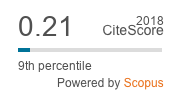Effects of Reinforcement History on Behavioral Variability
Keywords:
Behavioral variability, Learning sequences, Reinforcement historyAbstract
This study asked whether behavioral variability is influenced by the previous reinforcement experience. Rats
were exposed to schedules of reinforcement for sequences of four bar-press responses (right bar -R and left bar -L). In the CRF
schedule, every sequence was reinforced. In the other schedules, reinforcement was intermittent, being contingent upon sequence
variation (VAR) or independent of it (ACO). Variability was measured by the distribution of R or L responses within
the sequence. Half of the animals were exposed to the order CRF-VAR-CRF-ACO-CRF-VAR (group I) and half to CRFACO-
CRF-VAR-CRF-ACO (group II). All subjects showed the highest variability under VAR. During CRF and ACO contingencies,
no variability was observed if these contingencies preceeded VAR, but the levels of variability was intermediate if
they followed VAR. These results suggested that behavior variability is controlled by reinforcement experience.
Downloads
References
extinction, and reconditioning. Journal of Experimental
Psychology, 42, 273-281.
Attneave, F. (1959). Applications of information theory to psychology:
A summary of basic concepts, methods and results. New
York: Holt-Dryden Book.
Barba, L.S. (1997). Variabilidade comportamental aprendida.
Dissertação de Mestrado, Universidade de São Paulo, São Paulo.
Boren, J.J., Moerschbaecher, J.M. & Whyte, A.A. (1978). Variability
of response location on fixed-ratio and fixed-interval
schedules of reinforcement. Journal of the Experimental Analysis
of Behavior, 30, 63-67.
Catania, C.A. (1994). Learning. Englewood Cliffs: Prentice Hall.
Cohen, L., Neuringer, A. & Rhodes, D. (1990). Effects of ethanol
on reinforced variations and repetitions by rats under a multiple
schedule. Journal of the Experimental Analysis of Behavior,
54, 1-12.
Eckerman, D.A. & Lanson, R.N. (1969). Variability of response
location for pigeons responding under continuous reinforcement,
intermittent reinforcement, and extinction. Journal of the
Experimental Analysis of Behavior, 12, 73-80.
Herrnstein, R.J. (1961). Stereotypy and intermittent reinforcement.
Science 133, 2067-2069.
Herrnstein, R.J. (1970). On the law of effect. Journal of the Experimental
Analysis of Behavior, 76, 49-69.
Hunziker, M.H.L., Saldana, L. & Neuringer, A. (1996). Behavioral
variability in SHR and WKY rats as a function of rearing environment
and reinforcement contingency. Journal of Experimental
Analysis of Behavior, 65(1), 129-144.
Lachter, G.D. & Corey, J.R. (1982). Variability of the duration of
an operant. Behavior Analysis Newsletters, 2, 97-102.
Machado, A. (1989). Operant conditioning of behavior variability
using a percentile reinforcement schedule. Journal of the Experimental
Analysis of Behavior, 52, 155-166.
Machado, A. (1993). Learning variable and stereotypical sequences
of responses: Some data and a new model. Behavioral Processes,
30, 103-130.
Machado, A. (1997). Increasing the variability of response sequences
in pigeons by adjusting the frequency of switching
between two keys. Journal of the Experimental Analysis of
Behavior, 68, 1-25.
McCray, C.L. & Harper, R.S. (1962). Some relationships of schedules
of reinforcement to variability of responses. Journal of
Comparative and Physiological Psychology, 55, 19-21.
Mook, D.M. & Neuringer, A. (1994). Different effects of amphetamine
on reinforcement variations versus repetitions in spontaneously
hypertensive rats (SHR). Physiology and Behavior,
56, 939-944.
Morgan, L. & Neuringer, A. (1990). Behavioral variability as a
function of response topography and reinforcement contingency.
Animal Learning and Behavior, 18, 257-263.
Neuringer, A. (1986). Can people behave "randomly"?: The role of
feedback. Journal of Experimental Psychology: General, 115,
62-75.
Neuringer, A. (1991). Operant variability and repetition as functions
of interesponse time. Journal of Experimental Psychology:
Animal Behavior Processes, 17, 3-12.
Neuringer, A. (1992). Choosing to vary and repeat. Psychological
Science, 3, 246-250.
Neuringer, A. (1993). Reinforced variation and selection. Animal
Learning and Behavior, 21(2), 83-91.
Page, S. & Neuringer, A. (1985). Variability is an operant. Journal
of Experimental Psychology: Animal Behavior Processes, 11,
429-452.
Reid, A. (1994). Learning new response sequences. Behavioral
Processes, 32, 147-162.
Sagvolden, Т., Metzger, M., Schiorbeck, H., Rugland, A.,
Spinnange, I. & Sagvolden, G. (1992). The spontaneously hypertensive
rat (SHR) as an animal model of childhood hyperactivity
(ADHD): Changed reactivity to reinforcers and psychomotor
stimulants. Behavioral and Neural Biology, 58, 103-
112.
Schoenfeld, W.N. (1968). On the difference in resistence to extinction
following regular and periodic reinforcement. Journal of
the Experimental Analysis of Behavior, 11, 259-261.
Schwartz, B. (1982). Failure to produce response variability with
reinforcement. Journal of the Experimental Analysis of Behavior,
37, 171-181.
Skinner, B.F. (1948). "Superstition" in pigeon. Journal of the Experimental
Psychology, 38, 168-172.
Skinner, B.F. (1981). Selection by consequences. Science, 213,501-
504.
Stokes, P. (1995). Learned variability. Animal Learning and Behavior,
23, 164-176.
Stokes, P. & Balsam, P.D. (1991). Effects of reinforcing pre-selected
approximations on the topography of the rats bar press.
Journal of the Experimental Analysis of Behavior, 55, 213-
231.



